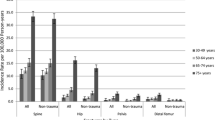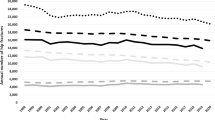Abstract
Summary
This analysis of National Health and Nutrition Examination Survey III data found a significant risk of incident hip fracture in adults aged 65 years and older who are candidates for treatment to lower fracture risk, according to the new National Osteoporosis Foundation Clinician's Guide.
Introduction
The relationship between treatment eligibility by the new National Osteoporosis Foundation (NOF) Guide to the Prevention and Treatment of Osteoporosis and the risk of subsequent hip fracture is unknown.
Methods
The study sample consisted of 3,208 men and women ages 65 years and older who were examined in the third National Health and Nutrition Examination Survey (NHANES III, 1988–1994), a nationally representative survey. Risk factors used to define treatment eligibility at baseline were measured in NHANES III or were simulated using World Health Organization study cohorts. Incident hip fractures were ascertained using linked mortality and Medicare records that were obtained for NHANES III participants through December 31, 2000. Cox proportional hazards models were used to estimate the relative risk (RR) of hip fracture by treatment eligibility status.
Results
The RR for subsequent hip fracture was 4.9 (95% CI 3.30, 7.94) in treatment-eligible vs treatment-ineligible persons. The increased risk for treatment-eligible persons remained statistically significant when examined by sex or age: RRmen = 5.5 (2.6, 11.4) and RRwomen = 4.3 (2.2, 8.4); RR65-79 y = 4.8 (2.6, 8.7) and RR80+ y = 4.6 (2.1, 10.1).
Conclusions
Treatment-eligible persons were about five times more likely to experience a subsequent hip fracture than the non-eligible persons. The new NOF guidelines appear to predict future hip fracture risk equally in men as in women, and fracture risk prediction did not appear to diminish with age.
Similar content being viewed by others
Notes
May be unreliable, estimate/standard error >30%
References
National Osteoporosis Foundation. (2008) Clinician's guide to prevention and treatment of osteoporosis. In. National Osteoporosis Foundation, Washington, DC, pp 1–36
National Osteoporosis Foundation. (2005) Physician's Guide to Prevention and Treatment of Osteoporosis. In. Washington, DC
Kanis J (2008) Assessment of osteoporosis at the primary health-care level. In Group WHOS (ed). WHO Collaborating Centre, University of Sheffield
Tosteson AN, Melton LJ 3rd, Dawson-Hughes B, Baim S, Favus MJ, Khosla S, Lindsay R (2008) Cost-effective osteoporosis treatment thresholds: the United States perspective. Osteoporos Int 19:437–447
Dawson-Hughes B, Looker A, Tosteson A, Johansson H, Kanis JA, Melton LJ (2009) The potential impact of new National Osteoporosis Foundation guidance on treatment patterns. Osteoporos Int 21:41–52
Plan and Operation of the Third National Health and Nutrition Examination Survey, 1988-94: series 1: programs and collection procedures. Vital Health Stat 1 (1994) 32:1–407
National Center for Health Statistics. Linkages among survey data from the National Center for Health Statistics and program data from the Centers for Medicare and Medicaid Services. Available at: http://www.cdc.gov/nchs/r&d/nchs_datalinkage/data_linkage_cms.htm Accessed on 9/16/09
National Center for Health Statistics. The Third National Health and Nutrition Examination Survey (NHANES III) Linked Mortality File: Matching Methodology. December 2005. Available at: www.cdc.gov/nchs/r&d/nchs_datalinkage/nhanes_data_linkage_activities.htm. Accessed on 9/20/06
Moon M (1991) What Medicare has meant to older Americans. Health Care Financ Rev 18:49–59
National Center for Health Statistics NCHS Definitions: Race. Available at http://www.cdc.gov/nchs/datawh/nchsdefs/race.htm. Accessed September 2, 2005
Ray WA, Griffin MR, Fought RL, Adams ML (1992) Identification of fractures from computerized Medicare files. J Clin Epidemiol 45:703–714
Looker AC, Mussolino ME (2008) Serum 25-hydroxyvitamin D and hip fracture risk in older U.S. white adults. J Bone Miner Res 23:143–150
Lamont EB, Lauderdale DS (2003) Low risk of hip fracture among elderly breast cancer survivors. Ann Epidemiol 13:698–703
Sanders KM, Pasco JA, Ugoni AM, Nicholson GC, Seeman E, Martin TJ, Skoric B, Panahi S, Kotowicz MA (1998) The exclusion of high trauma fractures may underestimate the prevalence of bone fragility fractures in the community: the Geelong Osteoporosis Study. J Bone Miner Res 13:1337–1342
Kanis JA, Johansson H, Oden A, Dawson-Hughes B, Melton LJ III, McCloskey EV (2009) The effects of a FRAX® revision for the USA. Osteoporos Int 21:35–40. doi:10.1007/s00198-009-1033-8
Ettinger B, Black DM, Dawson-Hughes B, Pressman AR, Melton LJ 3rd (2009) Updated fracture incidence rates for the US version of FRAX®. Osteoporos Int 21:25–33. doi:10.1007/s00198-009-1032-9
Dawson-Hughes B, Tosteson ANA, Melton LJ 3rd, Baim S, Favus MJ, Khosla S, Lindsay R (2008) Implications of absolute fracture risk assessment for osteoporosis practice guidelines in the USA. Osteoporos Int 19:449–458
Shah BV, Barnwell BG, Bieler GS (1995) SUDAAN User's Manual, Release 6.40. Research Triangle Institute, Research Triangle Park, NC
Schemper M, Stare J (1996) Explained variation in survival analysis. Stat Med 15:1999–2012
Donaldson MG, Cawthon PM, Lui L-Y, Schousboe JT, Ensrud KE, Taylor BC, Cauley JA, Hillier TA, Black DM, Bauer DC, Cummings SR, for the Study of Osteoporotic Fractures (2009) Estimates of the proportion of older white women who would be recommended for pharmacologic treatment by the new U.S. National Osteoporosis Foundation Guidelines. J Bone Miner Res 24:675–680
Richards JB, Leslie WD, Joseph L, Siminoski K, Hanley DA, Adachi JD, Brown JP, Morin S, Papaioannou A, Josse RG, Prior JC, Davison KS, Tenenhouse A, Goltzman D, for the CaMos Study Group (2007) Changes to osteoporosis prevalence according to method of risk assessment. J Bone Miner Res 22:228–234
Kanis JA, Oden A, Johnell O, Johansson H, De Laet C, Brown J, Burckhardt P, Cooper C, Christiansen C, Cummings S, Eisman JA, Fujiwara S, Gluer C, Goltzman D, Hans D, Krieg MA, La Croix A, McCloskey E, Mellstrom D, Melton LJ 3rd, Pols H, Reeve J, Sanders K, Schott AM, Silman A, Torgerson D, van Staa T, Watts NB, Yoshimura N (2007) The use of clinical risk factors enhances the performance of BMD in the prediction of hip and osteoporotic fractures in men and women. Osteoporos Int 18:1033–1046
Cummings SR, Nevitt MC, Browner WS et al (1995) Risk factors for hip fracture in white women. N Eng J Med 332:767–773
Langsetmo L, Goltzman D, Kovacs C et al (2009) Repeat low-trauma fractures occur frequently among men and women who have osteopenic BMD. J Bone Miner Res 24:1515–1522
Espallargues M, Sampietro-Colom L, Estrada MD, Sola M, del Rio L, Setoain J, Granados A (2001) Identifying bone-mass-related risk factors for fracture to guide bone densitometry measurements: a systematic review of the literature. Osteoporos Int 12:811–822
Leslie WD, Tsang JF, Lix LM, for the Manitoba Bone Density Program (2009) Simplified system for absolute fracture risk assessment: clinical validation in Canadian women. J Bone Miner Res 24:353–360
Kanis JA, Johnell O, Oden A, Dawson A, De Laet C, Jonsson B (2001) Ten year probabilities of osteoporotic fractures according to BMD and diagnostic thresholds. Osteoporos Int 12:989–995
Robbins J, Aragaki AK, Kooperberg C, Watts N, Wactawski-Wende J, Jackson RD, LeBoff MS, Lewis CE, Chen Z, Stefanick ML, Cauley J (2007) Factors associated with 5-year risk of hip fracture in postmenopausal women. JAMA 298:2389–2398
Black DM, Steinbuch M, Palermo L, Dargent-Molina P, Lindsay R, Hoseyni MS, Johnell O (2001) An assessment tool for predicting fracture risk in postmenopausal women. Osteoporos Int 12:519–528
Dargent-Molina P, Douchin MN, Cormier C, Meunier PJ, Bréart G, for the EPIDOS Study Group (2002) Use of clinical risk factors in elderly women with low bone mineral density to identify women at higher risk of hip fracture: the EPIDOS Prospective Study. Osteoporos Int 13:593–599
McGrother CW, Donaldson MMK, Clayton D, Abrams KR, Clarke M (2002) Evaluation of a hip fracture risk score for assessing elderly women: the Melton Osteoporosis Fracture (MOF) study. Osteoporos Int 13:89–96
MacLean C, Newberry S, Maglione M, McMahon M, Ranganath V, Suttorp M, Mojica W, Timmer M, Alexander A, McNamara M, Desai SB, Zhou A, Chen S, Carter J, Tringale C, Valentine D, Johnsen B, Grossman J (2008) Systematic review: comparative effectiveness of treatments to prevent fractures in men and women with low bone density or osteoporosis. Ann Intern Med 148:197–213
Kanis JA, Oden A, Johansson H, Borgström F, Ström O, McCloskey E (2009) FRAX® and its applications to clinical practice. Bone 44:734–743
Kanis JA, Johnell O, Oden A, McCloskey EV (2008) FRAX® and the assessment of fracture probability in men and women from the UK. Osteoporos Int 19:385–397
McCloskey EV, Johansson H, Oden A, Vasireddy S, Kayan K, Pande K, Jalava T, Kanis JA (2009) Ten-year fracture probability identifies women who will benefit from clodronate therapy—additional results from a double-blind, placebo-controlled randomised study. Osteoporos Int 20:811–817
Kanis JA, Johansson H, Oden A, McCloskey EV (2009) Bazedoxifene reduces vertebral and clinical fractures in postmenopausal women at high risk assessed with FRAX®. Bone 44:49–54
Burge R, Dawson-Hughes B, Solomon DH, Wong JB, King A, Tosteson A (2007) Incidence and economic burden of osteoporosis-related fractures in the United States, 2005-2025. J Bone Miner Res 22:465–475
Watts NB, Ettinger B, LeBoff MS (2009) FRAX facts. J Bone Miner Res 24:975–979
Conflicts of interest
Dr. Anne Looker: nothing to disclose
Dr. Bess Dawson-Hughes: National Osteoporosis Foundation, National Osteoporosis Foundation Physician Guide Committee chairman, International Osteoporosis Foundation; consultant to : Amgen, Cytochroma, Danone, GlaxoSmithKline, Johnson &Johnson, Eli Lilly, Merck, Pfizer, Procter and Gamble, Servier, and Unilever.
Dr. Anna Tosteson: National Osteoporosis Foundation Physician Guide Committee member, consultant to Amgen Inc. and Eli Lilly & Co.
Dr. Helena Johansson: nothing to disclose
Dr. John Kanis: nothing relevant to disclose
Dr. L. Joseph Melton: National Osteoporosis Foundation Physician Guide Committee member
Author information
Authors and Affiliations
Corresponding author
Additional information
The findings and conclusions in this report are those of the authors and do not necessarily represent the views of the Centers for Disease Control and Prevention, the Department of Health and Human Services, or the US Department of Agriculture.
Rights and permissions
About this article
Cite this article
Looker, A.C., Dawson-Hughes, B., Tosteson, A.N.A. et al. Hip fracture risk in older US adults by treatment eligibility status based on new National Osteoporosis Foundation guidance. Osteoporos Int 22, 541–549 (2011). https://doi.org/10.1007/s00198-010-1288-0
Received:
Accepted:
Published:
Issue Date:
DOI: https://doi.org/10.1007/s00198-010-1288-0




